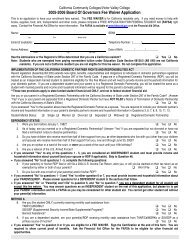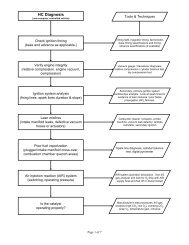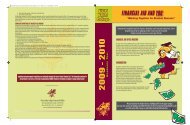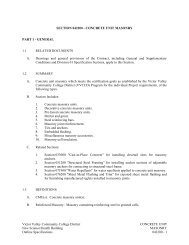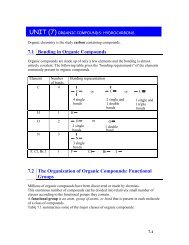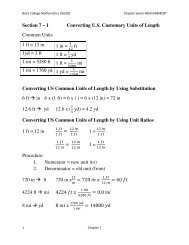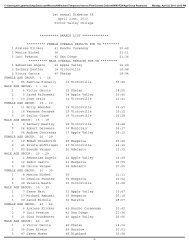Unit 9 - Carboxylic Acids, Esters, Amines, and Amides
Unit 9 - Carboxylic Acids, Esters, Amines, and Amides
Unit 9 - Carboxylic Acids, Esters, Amines, and Amides
You also want an ePaper? Increase the reach of your titles
YUMPU automatically turns print PDFs into web optimized ePapers that Google loves.
UNIT (9) CARBOXYLIC ACIDS, ESTERS, AMINES, AND AMIDES9.1 <strong>Carboxylic</strong> <strong>Acids</strong>The functional group in carboxylic acids is called the carboxyl group. A carboxyl groupis a carbonyl group (C = O) with a hydroxyl group (-OH) attached to the carbonyl carbonatom.ORepresentation of a carboxyl group C OH or COOH or CO 2 HO<strong>Carboxylic</strong> acid:RCOH(R = H, or aliphatic or aromatic hydrocarbon)9.2 Naming <strong>Carboxylic</strong> <strong>Acids</strong>The names of carboxylic acids end in “-oic acid,” indicating the presence of the carboxylgroup, ie: propanoic acid, butanoic acid, pentanoic acid, etc. When naming carboxylicacids, the “–e” is dropped from the alkane containing the carboxyl group <strong>and</strong> replacedwith “-oic acid”. The chain is numbered from the carboxylic acid group which is alwayslocated on the first carbon. The location of the functional group is not included in thename.Examples:CH 3 - COOH CH 3 - CH 2 - COOHCH 3 - CH 2 - CH 2 - COOHethanoic acid propanoic acidbutanoic acidCH 3CH 3 - CH - CH 2 - COOH4 3 2 13-methylbutanoic acidCOOHbenzoic acidSome members of this class are widely known by their common names. Common namesof acids you should know:HCOOHFormic acidCH 3 COOHAcetic acidA solution of acetic acid <strong>and</strong> water is known as vinegar.9-1
Worked Example 9-1Give the IUPAC name for each of the following compounds:Bra) (CH 3 ) 3 C-COOHb) CH 3 - CH - CH 2 - COOHCOOHOc)d)OHNO 2Solutiona) 2,2-dimethylpropanoic acid b) 3-bromobutanoic acidc) 4-nitrobenzoic acid d) 3,4-dimethylhexanoic acidPractice 9-1Name each of the following acids:a) CH 3 CH 2 CF 2 CH 2 COOHb) CH 3 - CH 2 - CH - COOHOHc)e)HOOHCOOHNH 2CH 3 - CH - COOHd)f)COOHCH 3OOHAnswera) 3,3-difluoropentanoic acid b) 2-hydroxybutanoic acidc) 3,4-dihydroxybenzoic acid d) 3-methylbenzoic acide) 2-aminopropanoic acid f) 2-ethylhexanoic acid9-2
9.3 Acidity of <strong>Carboxylic</strong> <strong>Acids</strong><strong>Carboxylic</strong> acids are weak acids. When a carboxylic acid is placed in water, the followingequilibrium is established.RCOOH + H 2 O RCOO - + H 3 O +carboxylicacidcarboxylateionCarboxylate ions are named by dropping the –ic ending from the name of the parent acid<strong>and</strong> replacing it with –ate.CH + H 2 O + H 3 O +3 COOH CH 3 COO -acetic acidacetate ionNeutralization of <strong>Carboxylic</strong> <strong>Acids</strong> (reaction of acids with bases)<strong>Carboxylic</strong> acids undergo neutralization reactions with strong bases as you have seen inunit 6.in a manner similar to that of inorganic acids. Neutralization of carboxylic acidsproduce a carboxylic acid salt <strong>and</strong> water.CH 3 COOH + NaOH CH 3 COO - Na + + H 2 Oacetic acid*sodium acetatecarboxylic acidcarboxylic acid salt*Note that carboxylic acid salts are named similarly to other ionic compounds (unit 4).The cation is named first, followed by the name of the anion.Worked Example 9-2Complete the following reaction <strong>and</strong> name the carboxylic acid salt formed.COOH+ KOHSolutionThe “protons” of the acid are removed by the OH - of the base to produce water.The cation of the base, in this case K + , forms the salt of the carboxylic acid.COOHCOO - K + + H+ KOH2 Obenzoic acidpotassiumbenzoate9-3
Practice 9-2Complete the following reaction <strong>and</strong> name the carboxylic acid salt formed.AnswerCH 3 - CH 2 - COOH +NaOHCH 3 - CH 2 - COOH + NaOH CH 3 - CH 2 - COO - Na + + H 2 Osodium propanoate9.4 <strong>Esters</strong><strong>Esters</strong> are derivative of carboxylic acids in which the –OH group on the carboxyl hasbeen replaced with an –OR group.OR - C - OHcarboxylic acidOR- C - OResterEsterification (Preparation of <strong>Esters</strong>)The process of esterification involves the reaction of a carboxylic acid with an alcohol inthe presence of an acid catalyst. Water is also a product in this reaction.The generalized reaction can be shown as:OR-C-OH +carboxylicacidR'-OHalcohol[H 2 SO 4 ]OR-C-OR'ester+H 2 OWhen ethanol is added to acetic acid <strong>and</strong> a drop of sulfuric acid (symbolized as H + ), thefollowing equilibrium will result:OCH 3 - C - OH+CH 3 -CH 2 -OH[H + ]OCH 3 - C - O - CH 2 -CH 3 +H 2 O9-4
Worked Example 9-3What carboxylic acid <strong>and</strong> alcohol are required to produce the following ester?OSolutionCH 3 - CH 2 - C - O - CH 2 -CH 2 -CH 2 -CH 3Separate the molecule by drawing a line down through the oxygen in the carbonchain. Add an –OH on both sides of your line to create the carboxylic acid on thecarbonyl side <strong>and</strong> the alcohol on the alkyl side.OCH 3 - CH 2 - C - OH HO - CH 2 -CH 2 -CH 2 -CH 3carboxylic acidalcohol(propanoic acid) (1-butanol)Worked Example 9-4Complete the following esterification reaction:O[H + ]CH 3 -C-OH+CH 3 -OHSolutionEach ester has an “acid part” <strong>and</strong> an “alcohol part”. The acid part is the carboxylicacid minus the –OH group. The alcohol part is an alcohol molecule, minus the Hatom of the –OH group. The –OH of the acid <strong>and</strong> the H of the alcohol form H 2 Omolecule.removal of OH<strong>and</strong> H produces the esterOCH 3 -C-OH+O[H + ]CH 3 -OH CH 3 -C-OCH 3+H 2 O9-5
Practice 9-3Complete the following esterification reaction:O[H + ]+ CHOH3 - CH 2 -OHAnswerremoval of OH<strong>and</strong> H produces the esterOOH+CH 3 - CH 2 -OH[H + ]O+O- CH 2 - CH 3H 2 O9.5 Naming <strong>Esters</strong>Ester names consist of two words.Use the alkyl portion of the alcohol name first.The -ic acid ending of the name of the carboxylic acid is replaced with –ate <strong>and</strong> followsthe first name.Examples:OCH 3 CH 2 COCH 3Methyl propanoateOCH 3 COCH 2 CH 2 CH 2 CH 3Butyl acetateWorked Example 9-5Name each of the following esters:Oa) CH 3 CH 2 COCH 2 CH 3b) COCH 3OOc) CH 3 CH 2 COd) COSolutiona) ethyl propanoate b) methyl benzoatec) cyclopentyl propanoate d) cyclobutyl benzoateO9-6
Practice 9-4Write the name for each of the following esters.a)Answerc)OCH 3 (CH 2 ) 5 CH 2 COCH 3b)OOCH 2 CH 3 d)O CH 3CO CHCH 3OCH 3 CH 2 CO CH 2 CH 2 CH 3a) methyl octanate b) isopropyl benzoatec) ethyl butanoate e) propyl propanoate9.6 The Hydrolysis of <strong>Esters</strong>Hydrolysis is a reaction in which an organic molecule reacting with water splits into twoparts, each of which has fewer carbons than the original organic molecule.<strong>Esters</strong> hydrolysis is a very slow reaction. The reaction is considerably more rapid undereither acidic or basic conditions.Ester hydrolysis under acidic condition (acid hydrolysis) is the reverse of acid-catalyzedester formation.Ester hydrolysis under basic condition (base hydrolysis) produces the metal carboxylatesalt instead of the carboxylic acid.I) Acid Hydrolysis of <strong>Esters</strong>Acid hydrolysis of esters requires the presence of a strong acid catalyst such as sulfuricacid. This reaction requires heat. The generalized hydrolysis can be shown as:OOH + , heatR - C - O - R' + H 2 OR - C - OH + R' - OHEster Acid Alcohol(This hydrolysis is the reverse of esterification.)9-7
Worked Example 9-6Complete the following reactions:OCH 3 -C-OCH 3+ H 2 OH +O-C-OCH 2 CH 3+ H 2 OH +SolutionTo write the hydrolysis product, under acidic condition, separate the compound atthe ester bond, producing the “parent” carboxylic acid <strong>and</strong> alcohol.OCH 3 -C-OCH 3+ H 2 OO-C-OCH 2 CH 3+ H 2 OH +H +OCH 3 -C-OH +O-C-OH+CH 3 -OHCH 3 CH 2 -OHII) Base Hydrolysis of <strong>Esters</strong>Base hydrolysis of esters is called saponification <strong>and</strong> it is used to manufacture soaps fromanimal fats <strong>and</strong> vegetable oils.The generalized hydrolysis can be shown as:OOH 2 OR - C - O - R' + NaOH R - C - O - Na + + R' - OHEster Carboxylate AlcoholsaltNotice that this reaction is not an equilibrium reaction (see arrow). The formation of saltdrives the equilibrium to the right, making the reaction irreversible.9-8
Worked Example 9-7Complete the following saponification (base hydrolysis) reactions:OCH 3 - C - OCH 2 CH 3O-C-OCH 3++NaOHNaOHH 2 OH 2 OSolutionThe hydrolysis of ester, under the basic condition, produces the carboxylic acidsalt <strong>and</strong> an alcoholOCH 3 - C - OCH 2 CH 3 + NaOHH 2 OOCH 3 - C - O - Na + + CH 3 CH 2 - OHethyl acetateO-C-OCH 3+NaOHH 2 Osodium acetateO-C-O - Na ++ CH 3 - OHmethyl benzoatesodium benzoate9-9
Practice 9-5Complete the following reactions:OCH 3 CH 2 -C-OCH 2 CH 3OCH 3 CH 2 -C-OCH 2 CH 3+ H 2 O+ NaOHH +H 2 OAnswerOCH 3 CH 2 -C-OCH 2 CH 3 + H 2 OH +OCH 3 CH 2 -C-OH+ CH 3 CH 2 OHOCH 3 CH 2 -C-OCH 2 CH 3 + NaOHH 2 OOCH 3 CH 2 -C-O - Na ++ CH 3 CH 2 OH9.7 <strong>Amines</strong>The three most common elements in organic compounds are carbon, hydrogen, <strong>and</strong>oxygen. <strong>Amines</strong> contain nitrogen <strong>and</strong> are commonly found in a wide variety ofbiomolecules <strong>and</strong> important pharmaceutical compounds. For this reason, nitrogen ranksfourth on the list of common elements found in organic compounds.<strong>Amines</strong> are considered organic derivatives of ammonia (NH 3 ) in which one or morehydrogen atoms are replaced by an alkyl or aromatic group.<strong>Amines</strong> are classified as primary, secondary, or tertiary, depending on the number oforganic groups directly attached to the nitrogen atom.HHRRH - N - HR - N - HR - N - HR - N - RAmmonia primary secondary tertiaryamine amine amine9-10
9.8 Naming <strong>Amines</strong>Common names are often used to name simple amines. If two or three alkyl groups arepresent, they are listed alphabetically along with the suffix –amine. The name is writtenas one word. Aromatic amines are usually named based on aniline.Examples:CH 3CH 3 - NH 2CH 3 CH 2 - NH 2 CH 3 CH 2 - NH - CH 3 CH3 - N - CH 3methylamine ethylamine ethylmethylamine trimethylamineNH 2NH 2Claniline3-chloroanilineWorked Example 9-8Name each of the following:a)CH 3 CH 2 CH 2 CH 2 CH 2 - NH 2b)CH 3 CH 2 CH 2 CH 2 - NH-CH 2 CH 2 CH 2 CH 3c)SolutionCH 3 CHCH 3CH 3 CH 2 CH 2 - N - CH 3d) N(CH 3 ) 2a) pentylamine(This amine has one alkyl group (pentyl) attached to the nitrogen atom.)b) dibutylamine(This amine has two identical alkyl groups (butyl) attached to the nitrogenatom.)c) isopropylmethylpropylamine(This amine has three alkyl groups (isopropyl, methyl, <strong>and</strong> propyl) attached tothe nitrogen atom.)d) cyclohexyldimethylamine(This amine has three alkyl groups (a cyclohexyl <strong>and</strong> two methyl group)attached to the nitrogen atom.)9-11
Practice 9-6Name each of the following:NH 2Bra)NH 2b)Brc)CH 3 (CH 2 ) 5 -NH-CH 2 CH 3d)NAnswera) cyclopentylamine b) 3,4-dibromoanilinec) ethylhexylamine d) diethylmethylamine9.9 Basicity of <strong>Amines</strong>Recall (unit 6) that ammonia is also a weak base <strong>and</strong> accepts H + from water to produceammonium ion (NH 4 + ) <strong>and</strong> hydroxide ion (OH - ):+NH 3 + H 2 O NH 4 + OH -ammoniaammoniumionBecause the amines are derivatives of ammonia, they react in a similar ways.General reaction R-NH 2 + H 2 O RNH 3 + + OH -+Specific reaction CH 3 - NH 2 + H 2 O CH 3 - NH 3 + OH -MethylaminemethylammoniumionJust as amines accept H + from water, they can accept H + from acids <strong>and</strong> form salts. Forexample, when methylamine reacts with HCl, the acid-base reaction producesmethylammonium chloride.CH 3 – NH 2 + HCl → CH 3 – NH + 3 Cl -methylamine acid methylammonium chloride9-12
9.10 <strong>Amides</strong>The functional group of an amide is a carbonyl group (C = O) linked to a nitrogen atom(N). <strong>Amides</strong> are classified as primary, secondary, <strong>and</strong> tertiary amides.OR - C - N - HOR - C - N - R'R - C - N - R'HHR''primary secondary tertiaryR, R′, <strong>and</strong> R′′ could be aliphatic or aromatic.O9.11 Naming <strong>Amides</strong>Naming Primary <strong>Amides</strong>The ending of the name of the carboxylic acid is changed from –ic acid (common) or –oicacid (IUPAC) to –amide.ExamplesOOOCH 3 CH 2 CNH 2CH 3 CH 2 CH 2 CNH 2NH 2PropanamidebutanamidehexanamideNaming Secondary <strong>and</strong> Tertiary <strong>Amides</strong>The names of groups attached to nitrogen are placed first, using an N-prefix for eachgroup.O CH 3 O CH 3CH 3 - CH 2 - C - N - HCH 3 - CH 2 - C - N - CH 3N-methylpropanamideN,N-dimethylpropanamideOCH 3CH 3 - CH 2 - C - N - CH 2 -CH 3N-ethyl-N-methylpropanamide9-13
Worked Example 9-9Name each of the following amides:OOC - NH 2a)CH 3 - CH 2 - CH 2 - CH 2 - C -NH 2b)c)OCH 3 - C - NH 2 d)OH - C - NH 2Solutiona) pentanamide b) benzamidec) acetamide (ethanamide) d) formamide (methanamide)Practice 9-7Name each of the following amides:OO Ha) CH 3 - C - Nb)C - NH - CH 2 -CH 3c) CH 3 - CH 2 - CH 3 - CH 2 - C - NHOAnswera) N-cyclohexylacetamide b) N-ethylbenzamidec) N-isopropylpentanamide9-14
9.12 Hydrolysis of <strong>Amides</strong><strong>Amides</strong> are very stable in water. Hydrolysis requires the heating of the amide in thepresence of strong acid or base. Acidic hydrolysis gives a carboxylic acid <strong>and</strong> an aminesalt.In aqueous base, the products of hydrolysis are a carboxylic acid salt <strong>and</strong> ammonia or anamine.General Reactions:Acid Hydrolysis of <strong>Amides</strong>OR - C - NH - R' + H 2 O + HClheatOR - C - OH + R' - NH 3 + Cl -Base Hydrolysis of <strong>Amides</strong>OR - C - NH - R' + NaOHheatOR - C - O - Na + + R' - NH 2Example of Acid Hydrolysis of Amide:OOCH 3 - C - NH 2+ H 2 O + HClCH 3 -C-OH+NH 4 Clacetamidewaterhydrochloricacidacetic acidammoniumchlorideExample of Base Hydrolysis of Amide:OCH 3 - C - NH 2acetamide+NaOH CH 3 - C - O - Na +sodiumhydroxideOsodiumacetate+NH 3ammonia9-15
Worked Example 9-10Draw the structures of the products in each of the following hydrolysis reactions.OC - NH 2+NaOHheatAnswerOCH 3 - CH 2 - C - NH - CH 3+ H 2 O + HClheatOC NH 2OC O - Na ++ NaOHheat+ NH 3OCH 3 - CH 2 - C - NH - CH 3 + H 2 O + HClheatOCH 3 - CH 2 - C - OH+CH 3 -NH 3 + Cl -9-16
Practice 9-8Draw the structures of the products in each of the following hydrolysis reactions.OC - NH 2+ H 2 O + HClheatAnswerOCH 3 - CH 2 - C - NH - CH 3+ NaOHheatOOC NH 2C+ H 2 O + HClheatOH+ NH 4 + Cl -OCH 3 - CH 2 - C - NH - CH 3 + NaOHheatOCH 3 - CH 2 - C - O - Na ++CH 3 -NH 29-17
Homework Problems9.1 Give the name for each of the following:COOHa.ClClb.OOHc.CH 3CH 3 - CH -CH 2 - COOHd.( CH 3 CH 2 ) 3 CCOOH9.2 Draw the structural formula for each of the following compounds:a. sodium hexanoateb. potassium acetatec. zinc benzoated. calcium propanoate9.3 Complete the following reactions:a.OCH 3 -C-OH+CH 3 CH 2 CH 2 OH[H + ]b.(CH 3 ) 3 CCH 2 CH 2 COOH+(CH 3 ) 2 CHOH[H + ]c.COOH+CH 3 CH 2 OH[H + ]d.CH 3 (CH 2 ) 2 COOH+OH[H + ]9-18
9.4 Draw a structural formula for each of the following esters:a. cyclohexyl propanoateb. methyl formatec. ethyl benzoated. isopropyl acetatee. butyl butanoatef. propyl pentanoate9.5 Assign names to each of the following amines:a.NH 2b.c.CH 3 - NH - CH 2 - CH 3(CH 3 CH 2 ) 3 Nd.NH - CH 3e.f.CH 3 CH 2 CH 2 - NH 2N9.6 Complete the following equations:a.CH 3 CH 2 NH 2+HClNH 2b.+HClc.CH 3 CH 2 NH-CH 3+HBrd.N(CH 3 ) 2+HBr9.7 Draw the structures of 4 isomers of amides of formula C 5 H 11 NO.9-19




